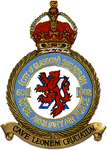Maestro
Master Sergeant
Greetings ladies and gentlemen.
I would like to know if any of you got more info on history of the 602 "City Of Glasgow" Squadron. The only infos I have are about their role in BoB. Here is what I have :
Aircraft: Spitfire Mk.1
Motto: Cave leonem cruciatum - 'Beware the tormented lion'
Badge: In front of a saltire, a lion rampant. The lion was adopted in view of the squadron's association with Scotland and the saltire to represent the cross of St Andrew, being fimbriated to show it as a white saltire on a blue background.
No 602 Squadron was formed on 12 September 1925 at Renfrew as a day bomber unit of the Auxiliary Air Force. Initially equipped with DH9As it began to replace these with Fawns in September 1927, though the latter were in turn replace by Wapitis in 1929. Harts began to arrive in February 1934 and the squadron re-equipped with Hinds in June 1936. On 1 November 1938 No 602 was redesignated an army co-operation squadron, but on 14 January 1939 this was changed to become a fighter unit, Gauntlets being received. These were replaced by Spitfires in May 1939 and during the early months of the war the squadron was engaged in intercepting German bombing raids on Scotland. When the Battle of Britain began, No 602 was still in Scotland, moving south in mid-August.
I would like to know if any of you got more info on history of the 602 "City Of Glasgow" Squadron. The only infos I have are about their role in BoB. Here is what I have :
Aircraft: Spitfire Mk.1
Motto: Cave leonem cruciatum - 'Beware the tormented lion'
Badge: In front of a saltire, a lion rampant. The lion was adopted in view of the squadron's association with Scotland and the saltire to represent the cross of St Andrew, being fimbriated to show it as a white saltire on a blue background.
No 602 Squadron was formed on 12 September 1925 at Renfrew as a day bomber unit of the Auxiliary Air Force. Initially equipped with DH9As it began to replace these with Fawns in September 1927, though the latter were in turn replace by Wapitis in 1929. Harts began to arrive in February 1934 and the squadron re-equipped with Hinds in June 1936. On 1 November 1938 No 602 was redesignated an army co-operation squadron, but on 14 January 1939 this was changed to become a fighter unit, Gauntlets being received. These were replaced by Spitfires in May 1939 and during the early months of the war the squadron was engaged in intercepting German bombing raids on Scotland. When the Battle of Britain began, No 602 was still in Scotland, moving south in mid-August.

